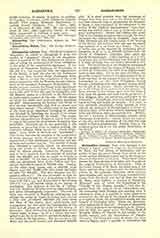

Alexandrian Library, the. —The Great Library of Alexandria, so called to distinguish it from the smaller or “daughter” library in the Serapeum, was a foundation of the first Ptolemies for the purpose of aiding the maintenance of Greek civilization in the midst of the conservative Egyptians. If the removal of Demetrius Phalereus to Alexandria, in 296-295 B.C., was connected with the organization of the library, at least the plan for this institution must have been formed under Ptolemaios Soter (died c. 284 B.C.), but the completion of the work and its connection with the Museum was the achievement of his successor, Ptolemaios Philadelphos. As Strabo does not mention the library in his description of the buildings upon the harbor, it is clear that it was not in that part of the city, and its connection with the Museum points to a location in the Brucheion, or northwestern quarter of the city. Of the means by which the books were acquired many anecdotes are told. Ships entering the harbor were forced to give up any manuscripts they had on board and take copies instead. The official copy of the works of the three great tragedians belonging to Athens was retained by forfeiting the deposit of 15 talents that had been pledged for its return. The rivalry between Alexandria and Pergamon was so keen that to cripple the latter the exportation of papyrus was prohibited. Necessity led to the perfecting of the methods of preparing skins to receive writing, the improved material being known as “charta pergamena”, from which is derived our “parchment”. This rivalry was also the occasion of the composition of many spurious works, of devices for giving to manuscripts a false appearance of antiquity, and also of hasty and careless copying. The number of books thus obtained is variously stated, the discrepancy being due partly to the fact that the statements refer to various periods. Demetrius Phalereus is said to have reported that the number of papyrus rolls was 200,000, but that he hoped to increase it soon to 500,000. In the time of Callimachos 490,000 rolls are mentioned; later, Aulus Gellius and Ammianus Marcellinus speak of 700,000 rolls. Orosius, on the other hand, speaks only of 400,000, while Seneca says that 40,000 rolls were burnt (probably an error for 400,000). The first librarian was Zenodotus (234 B.C.). He was succeeded in turn by Eratosthenes (234-195 B.C.); Aristophanes of Byzantium (195-181 B.C.); and Aristarchos of Samothrace (181-171 B.C.), all famous names in the history of scholarship. The inclusion in this list of Callimachos and Apollonios Rhodios rests on slight authority and seems chronologically impossible. The work of these men consisted in classifying, cataloguing, and editing the works of Greek literature and exerted a deep and permanent influence not only upon the form of the books, their subdivisions, and arrangement, but also upon the transmission of the texts and all phases of the study of the history of literature. After Aristarehos the importance of the library began to wane. In 47 B.C. Caesar was compelled to set fire to his fleet to prevent its falling into the hands of the Egyptians. The fire spread to the docks and the naval arsenal, and destroyed 400,000 rolls. It is most probable from the statement of Orosius that these were not in the library itself, but had been removed from it preparatory for shipment to Rome, a view confirmed by the statement of the author of the “Bellum Alexandrinum” that Alexandria was built in such a way as to be safe from a great conflagration. Seneca and Gellius also speak only of the burning of manuscripts, though the latter represents the destruction as complete. Less carefully, Plutarch and Dio Cassius speak of the burning of the library, but had this been the case we should find mention of it in Cicero and Strabo. The loss of books was partly repaired by Anthony’s gift to Cleopatra, in 41 B.C., of 200,000 volumes from the library of Pergamon. Domitian drew upon the library for transcripts. Under Aurelian, in A.D. 272, the greater part of the Brucheion was destroyed, and it is most probable that the library perished at this time. The small library in the Serapeum is supposed to have perished when the temple of Serapis was destroyed by Theophilus, but there is no definite statement to that effect. Up to the time of Gibbon, the generally accepted version of the destruction of the library was that, on the capture of the city by the Mahommedans in A.D. 642, John Philoponos, having formed a friendship with their general Amrou, asked for the gift of the library. Amrou referred the matter to the Caliph Omar and received the answer: “If these writings of the Greeks agree with the book of God, they are useless, and need not be preserved; if they disagree, they are pernicious, and ought to be destroyed.” Accordingly, they were employed in the baths as fuel, and lasted six months. This story is now generally discredited, chiefly because it rests only on the authority of Abulpharagius, a writer six centuries later, while earlier writers, especially Eutychius and Elmacin, make no mention of it. Besides, the act is contrary to Mohammedan custom; John Philoponos lived about a century before the capture of the city, and the statement of the time the rolls lasted as fuel is preposterous. Finally, there is the evidence given above for the earlier destruction of the library.
GEORGE MELVILLE BOLLING

